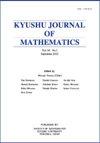THE BOUNDARY LERCH ZETA-FUNCTION AND SHORT CHARACTER SUMS À LA Y. YAMAMOTO
IF 0.5
4区 数学
Q3 MATHEMATICS
引用次数: 4
Abstract
. As has been pointed out by Chakraborty et al (Seeing the invisible: around generalized Kubert functions. Ann. Univ. Sci. Budapest. Sect. Comput. 47 (2018), 185–195), there have appeared many instances in which only the imaginary part—the odd part—of the Lerch zeta-function was considered by eliminating the real part. In this paper we shall make full use of (the boundary function aspect of) the q -expansion for the Lerch zeta-function, the boundary function being in the sense of Wintner (On Riemann’s fragment concerning elliptic modular functions. Amer. J. Math. 63 (1941), 628–634). We may thus refer to this as the ‘Fourier series–boundary q -series’, and we shall show that the decisive result of Yamamoto (Dirichlet series with periodic coefficients. Algebraic Number Theory. Japan Society for the Promotion of Science, Tokyo, 1977, pp. 275–289) on short character sums is its natural consequence. We shall also elucidate the aspect of generalized Euler constants as Laurent coefficients after a brief introduction of the discrete Fourier transform. These are rather remote consequences of the modular relation, i.e. the functional equation for the Lerch zeta-function or the polylogarithm function. That such a remote-looking subject as short character sums is, in the long run, also a consequence of the functional equation indicates the ubiquity and omnipotence of the Lerch zeta-function—and, a fortiori , the modular relation (S. Kanemitsu and H. Tsukada. Contributions to the Theory of Zeta-Functions: the Modular Relation Supremacy. World Scientific, Singapore, 2014). (1.6), the Lerch zeta-function (1.4) is less well known, the existing monograph [ 36 ] notwithstanding. Recently there has been a new representation-theoretic interpretation of the Lerch zeta-function, cf. e.g. [ 35 ]. In the last few decades, the most fundamental and influential works related to the Lerch zeta-function are [ 16 ], [ 43 ], [ 47 ], and [ 71 ], which are partly incorporated in [ 10 ]. We shall describe these toward the end of this section. In the paper [ 9 ] the ubiquity of the Lerch zeta-function, especially the monologarithm (cid:96) 1 ( x ) (1.22) of the complex exponential argument, has been pursued.边界奇ζ函数和短字符和À la . yamamoto
. 正如Chakraborty等人(Seeing the invisible: around generalized Kubert functions)所指出的那样。安。大学,科学。布达佩斯。在第47节(2018),185-195节)中,出现了许多例子,其中通过消除实部只考虑Lerch ζ函数的虚部-奇部。本文充分利用了lach ζ函数的q展开(边界函数方面),该边界函数是关于椭圆模函数的Wintner (On Riemann’s fragment)意义上的。阿米尔。数学学报,63(1941),628-634。因此,我们可以把它称为“傅立叶级数-边界q级数”,我们将证明具有周期系数的山本(Dirichlet)级数的决定性结果。代数数论。日本科学促进会,东京,1977年,第275-289页)的短字符和是其自然结果。在简要介绍离散傅里叶变换之后,我们还将阐明广义欧拉常数作为洛朗系数的方面。这些都是模关系的相当远的结果,即,对于勒奇ζ函数或多对数函数的函数方程。从长远来看,像短字符和这样一个看似遥远的主题,也是函数方程的一个结果,这表明了莱奇ζ函数的普遍性和全能性,更重要的是,模关系(S. Kanemitsu和H. Tsukada)。对ζ函数理论的贡献:模关系至上。世界科学,新加坡,2014)。(1.6), Lerch ζ函数(1.4)不太为人所知,尽管现有的专著[36]。最近出现了一种新的对莱奇ζ函数的表示理论解释,例如[35]。近几十年来,与Lerch ζ函数相关的最基础、最具影响力的工作是[16]、[43]、[47]和[71],它们部分被纳入[10]。我们将在本节末尾描述这些特性。本文讨论了lach ζ函数的普遍性,特别是复指数参数的单对数(cid:96) 1 (x)(1.22)。
本文章由计算机程序翻译,如有差异,请以英文原文为准。
求助全文
约1分钟内获得全文
求助全文
来源期刊
CiteScore
0.80
自引率
0.00%
发文量
10
审稿时长
>12 weeks
期刊介绍:
The Kyushu Journal of Mathematics is an academic journal in mathematics, published by the Faculty of Mathematics at Kyushu University since 1941. It publishes selected research papers in pure and applied mathematics. One volume, published each year, consists of two issues, approximately 20 articles and 400 pages in total.
More than 500 copies of the journal are distributed through exchange contracts between mathematical journals, and available at many universities, institutes and libraries around the world. The on-line version of the journal is published at "Jstage" (an aggregator for e-journals), where all the articles published by the journal since 1995 are accessible freely through the Internet.

 求助内容:
求助内容: 应助结果提醒方式:
应助结果提醒方式:


